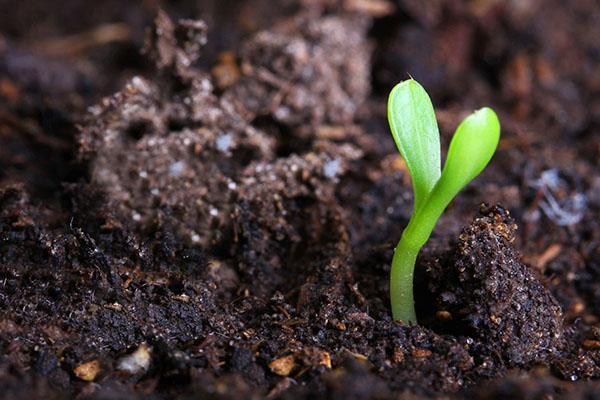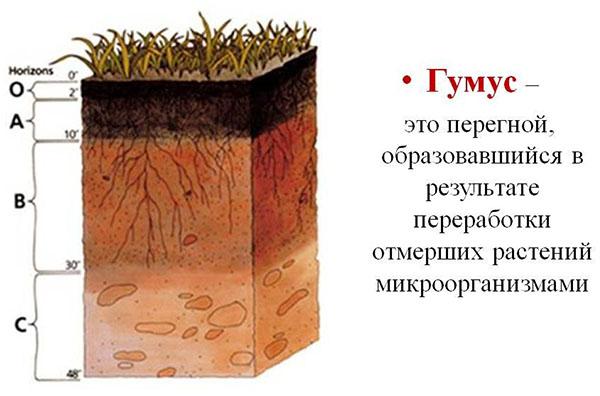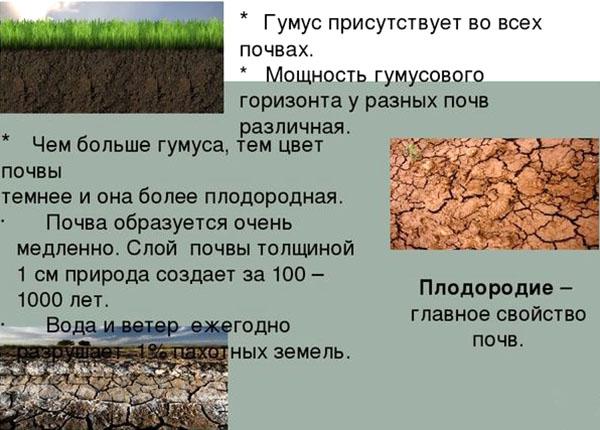What is humus and how to control its content in the garden?
 The fertility of the soil and a rich harvest directly depend on its composition. Understanding correctly what humus is, a gardener will be able to achieve excellent results in his business. Some people mistakenly think it is manure or compost. Of course, without these components, the process of plant growth and development is impossible. Nevertheless, they cannot be called full-fledged humus. This issue should be understood in more detail in order to know how to proceed.
The fertility of the soil and a rich harvest directly depend on its composition. Understanding correctly what humus is, a gardener will be able to achieve excellent results in his business. Some people mistakenly think it is manure or compost. Of course, without these components, the process of plant growth and development is impossible. Nevertheless, they cannot be called full-fledged humus. This issue should be understood in more detail in order to know how to proceed.
What is humus from the point of view of agronomy

- bacteria;
- all kinds of insects;
- fungal spores;
- lichens;
- annelids and other invertebrates.
 Over the course of several years, they recycle the remains, as well as waste products of underground flora and fauna. As a result, organic compounds accumulate in the earth, which serve as "food" for cultivated plants. Worms play a special role in how humus is formed. They not only eat organic debris, but also loosen the area with high quality. Thanks to their "activity", the soil is saturated with a sufficient amount of oxygen and moisture.
Over the course of several years, they recycle the remains, as well as waste products of underground flora and fauna. As a result, organic compounds accumulate in the earth, which serve as "food" for cultivated plants. Worms play a special role in how humus is formed. They not only eat organic debris, but also loosen the area with high quality. Thanks to their "activity", the soil is saturated with a sufficient amount of oxygen and moisture.
How to determine the humus content in the soil? Laboratories use the Tyurin method, but under normal conditions the color of the soil indicates its presence. The darker the substrate, the more nutrients it contains.
Humus-rich lands contain up to 90% nitrogenous compounds. They also include:
- fulvic acids;
- phosphorus and sulfuric substances;
- humic acids.
 All these components create a valuable soil structure, providing plants with the proper acid-base balance. In addition, they stimulate the growth of green mass and the development of the root system of crops.
All these components create a valuable soil structure, providing plants with the proper acid-base balance. In addition, they stimulate the growth of green mass and the development of the root system of crops.
Classification of soils by humus content: learning to distinguish the composition of the soil
 In each separate natural zone, its "concentration" depends on many factors. In addition, the degree of cultivation of territories affects the quality of this valuable component of fertility. There are several classifications of soils based on humus content.
In each separate natural zone, its "concentration" depends on many factors. In addition, the degree of cultivation of territories affects the quality of this valuable component of fertility. There are several classifications of soils based on humus content.
They can be conditionally divided into 4-6 categories:
- Low-humus (up to 2%). Brown, gray-brown or desert.
- Moderate humic (2-4%). Forest gley or chestnut soils. Sod-podzolic soil types are found in deciduous forests.
- Medium humus (4-6%). Brown forest lands, which are cultivated for sowing cultivated plants.
- Humic (6-10%). These include chernozems, which determine the properties of soil humic substances. Very often they are applied to depleted areas to increase fertility.
- Humus (15-30%).
- Peat (over 30%).

Chernozems are unusually dark in color. Therefore, their surface warms up better in the sun, and also retains heat for a long time.
 Podzolic soils are among the poorest. They are found in coniferous forests, where the top layer of the earth is presented in the form of mulch. There is practically no vegetation in these places, so the microorganisms have nothing to process. The largest amount of humus is contained in soils belonging to chernozems. They are found mainly in the southern regions of Russia.
Podzolic soils are among the poorest. They are found in coniferous forests, where the top layer of the earth is presented in the form of mulch. There is practically no vegetation in these places, so the microorganisms have nothing to process. The largest amount of humus is contained in soils belonging to chernozems. They are found mainly in the southern regions of Russia. 

How to increase the humus content in your garden
 The above examples of the classification of the nutrient value of the soil substrate are relative. However, knowing exactly what humus is, you can independently create favorable conditions for growing many crops. In most cases, its concentration depends on a sufficient amount of vegetation, as well as organic matter in the soil.
The above examples of the classification of the nutrient value of the soil substrate are relative. However, knowing exactly what humus is, you can independently create favorable conditions for growing many crops. In most cases, its concentration depends on a sufficient amount of vegetation, as well as organic matter in the soil.
Therefore, it is recommended to systematically introduce into the garden:
- manure (cow, horse);
- peat;
- bird droppings;
- compost;
- turf.
 One hundred square meters of each fertilizer will need 150-200 kg. For such purposes, slowly decomposing organic matter is chosen: manure or compost. This increases nutrient levels by up to 30%. Rapidly disintegrating fertilizers (slurry, mullein, or bird droppings) are used only as top dressing. At the same time, many farmers independently create such a compost composition.
One hundred square meters of each fertilizer will need 150-200 kg. For such purposes, slowly decomposing organic matter is chosen: manure or compost. This increases nutrient levels by up to 30%. Rapidly disintegrating fertilizers (slurry, mullein, or bird droppings) are used only as top dressing. At the same time, many farmers independently create such a compost composition.
On one pile they drop:
- weeds;
- food waste;
- used bedding for livestock;
- fallen leaves;
- tops and other crop residues.
It should be understood that it will take enough time to form high-quality compost. To speed up this process, farmers populate the formed mass of worms. As a result, in 3-6 months the substrate will be ready for use.
Manure or humus is recommended to be mixed with chopped straw. This will increase the amount of humus to 700 kg / ha.
Secrets of processing a vegetable garden
 They also advise on the site to create favorable conditions that allow plants to fully assimilate nutrients.
They also advise on the site to create favorable conditions that allow plants to fully assimilate nutrients.
To do this, take into account the basic rules for digging a garden:
- fertilizers are embedded in the soil evenly;
- when growing perennial shrubs or trees, organic matter is placed in a hole at a depth of 50-80 cm;
- vegetables are planted after incorporating humus to a depth of 40-60 cm.
In addition, the beds are very often loosened to provide oxygen and moisture to soil microorganisms. To maintain such a microclimate, farmers mulch aisles.
They often make it from:
- films;
- coniferous litter;
- sawdust;
- herbs.
The use of green manure on the site increases the humus content in the soil. As such "green fertilizers" are used: lupine, mustard, legumes, phacelia and buckwheat.
 The leading role in fertility is played by the correct crop rotation technique. If you alternate planting different crops in the same place, then the amount of humus practically does not change. Otherwise, the crops of one family begin to absorb the entire supply of useful components from the soil, thereby depleting the land. This contributes to the creation of a favorable environment for the development of all kinds of pests and diseases.
The leading role in fertility is played by the correct crop rotation technique. If you alternate planting different crops in the same place, then the amount of humus practically does not change. Otherwise, the crops of one family begin to absorb the entire supply of useful components from the soil, thereby depleting the land. This contributes to the creation of a favorable environment for the development of all kinds of pests and diseases.
Knowing what humus is allows you to control its level in your area. The rational use of organic fertilizers, as well as the correct cultivation of the beds, will help to preserve all the useful trace elements and increase crop yields.